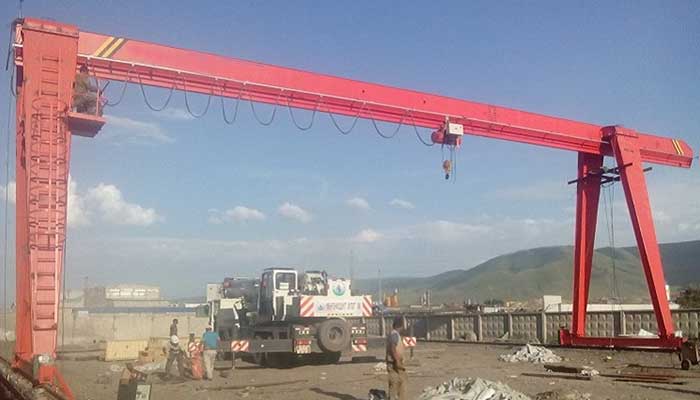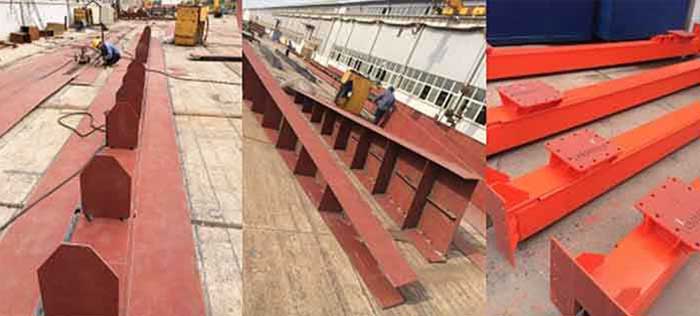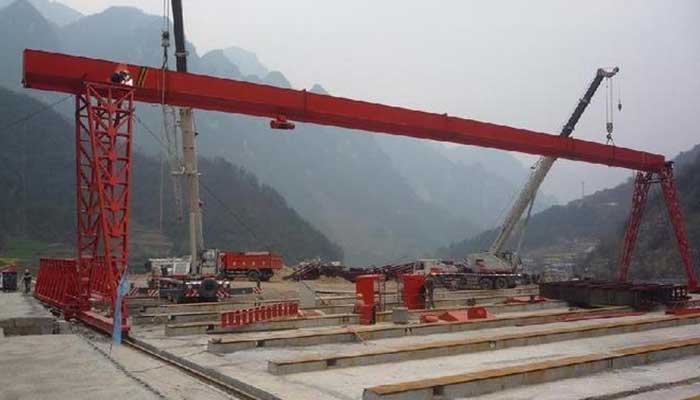20 Ton Gantry Cranes in Cement Plants for Bulk Material Handling
20 Ton Gantry Cranes in Cement Plants for Bulk Material Handling
Cement, a fundamental material in construction, is a result of a meticulous manufacturing process involving various stages, each crucial in creating the final product. At the heart of this process lies the efficient handling of bulk materials like limestone, clay, and gypsum. In cement plants worldwide, the seamless movement of these raw materials is pivotal for uninterrupted production and superior product quality.
Cement manufacturing is a complex and continuous operation that demands precise handling of raw materials. From the extraction of limestone to the blending and grinding stages, every phase requires careful attention to ensure the right materials are processed at the right time. Any inefficiency or delay in material handling can significantly impact production schedules, resulting in downtime and affecting the overall output and quality.
In this intricate process, one of the key components facilitating smooth operations is the application of specialized equipment. Among these, the 20 Ton gantry crane emerges as a crucial asset in the handling of bulk materials within cement plants.
Introduction to 20 Ton Gantry Cranes and Their Role in Bulk Material Handling
Gantry cranes, a type of overhead crane system, serve as the workhorse in material handling tasks across various industries. Specifically designed to lift and transport heavy loads horizontally, these cranes offer unparalleled versatility, making them a cornerstone in the efficient operation of cement plants.
The 20 Ton gantry crane, in particular, stands out as a formidable force in the bulk material handling domain. Its ability to efficiently lift and move substantial quantities of raw materials, such as limestone, clay, and gypsum, has positioned it as an indispensable tool in the cement manufacturing process.
These cranes, with their robust build and superior load-bearing capacities, play a pivotal role in streamlining material handling operations, ensuring consistent and continuous production cycles. Let's delve deeper into their functionalities and the impact they have on enhancing efficiency within cement plants.
Single girder gantry crane for cement factory
Role of Gantry Cranes in Cement Manufacturing
Understanding Bulk Material Handling in Cement Plants
Bulk material handling is the backbone of cement manufacturing. From the initial stage of obtaining raw materials to the final product, the efficient handling of materials like limestone, clay, and gypsum is critical. Gantry cranes, particularly the 20 Ton variants, shoulder the responsibility of ensuring these raw materials are seamlessly moved throughout the production process.
Importance of Efficient Handling for Limestone, Clay, and Gypsum
Limestone, clay, and gypsum are the primary raw materials in cement manufacturing. Their correct proportioning and timely delivery to the processing units are vital for maintaining the quality and consistency of the final cement product. The 20 Ton gantry cranes excel in this aspect, offering the strength and precision necessary to handle these heavy and diverse materials.
Specific Requirements for Handling Bulk Materials in Cement Production
In the realm of cement production, each raw material has unique characteristics that demand specific handling requirements. Limestone, for instance, needs careful handling due to its abrasive nature. Clay and gypsum also present their own challenges, necessitating precise and efficient material handling techniques. The 20 Ton gantry cranes, with their customizable features and adaptability, are tailor-made to meet these varied material handling needs.
The importance of these cranes in efficiently moving these bulk materials cannot be overstated. Their ability to handle such substantial loads and maintain a smooth flow of materials is crucial for optimizing production throughput and maintaining operational efficiency in cement plants.
Gantry crane underconstruction for cement factory
As for the Central Asia gantry crane project the main information is as follow:
- Project Name: Construction of cement production line
- Industry: Building Materials Manufacturing Industry
- Crane: Gantry crane main profile:
- Quantity: 2 sets
- Crane Model: MH5t-24m
- Crane span: 24 meters
- Crane lifting height: 9 m
- Crane hanging outside: one side of hanging beam with 5 meters cantilever
- Crane working level: A4
- Gantry crane operation: ground operate, driver’s cabin control
- Crane long traveling distance: 150 meters
- Crane lifting materials: sand, cement and cement products
- Crane configuration: Schneider Electric, soft start motor, motor protection class IP54, insulation class F.
- Crane ambient temperature: -40 ℃ -40 ℃
The electric hoist gantry crane using under the environment with perennial big wind speed, big wind sand, the crane installed with rail clamp, anemometer, electrical box with temperature control device, and anti-cold cables, etc. Hoisting mechanism traveling track using C-type steel slide.
Characteristics of 20 Ton Gantry Cranes
Design and Structural Features
20 Ton gantry cranes are engineered with robust designs, utilizing high-quality materials to withstand the demanding environment of cement plants. Their sturdy construction comprises steel beams, girders, and frames, ensuring durability and stability during heavy-duty operations. The design also includes safety features such as overload protection systems and emergency braking mechanisms.
Load-Bearing Capacities and Specifications
These gantry cranes boast impressive load-bearing capacities, efficiently handling materials up to 20 tonnes, meeting the demands of the cement industry for transporting bulk materials like limestone, clay, and gypsum. Their specifications are fine-tuned to ensure seamless movement, precise positioning, and safe handling of these heavy loads within the plant premises.
Versatility and Adaptability in Cement Plant Operations
One of the key advantages of the 20 Ton gantry cranes is their versatility in adapting to various operational requirements within cement plants. These cranes can be equipped with different attachments, such as spreader bars or specialized lifting devices, enabling them to handle diverse materials and accommodate different production processes. Their adaptability ensures optimized material flow and enhances the overall efficiency of cement manufacturing operations.
The design, load-bearing capacities, and adaptability of these 20 Ton gantry cranes are pivotal in the efficient handling of bulk materials, facilitating a streamlined workflow and contributing significantly to the productivity of cement plants.
Cement plant gantry crane
Applications of 20 Ton Gantry Cranes in Cement Plants
Handling Bulk Materials in Raw Material Processing
Within cement plants, 20 Ton gantry cranes play a crucial role in the initial stages of material processing. They efficiently handle raw materials like limestone, clay, and gypsum, ensuring a continuous supply to the subsequent production stages. These cranes are instrumental in unloading materials from trucks or wagons and stockpiling them for further processing.
Usage in Various Stages of Cement Manufacturing
Throughout the cement manufacturing process, these gantry cranes are involved in different stages. They transport materials from storage yards to crushers, mills, and blending facilities. Additionally, these cranes facilitate the movement of materials to the pre-heater tower and the kiln feed, where these raw materials undergo critical processes before transforming into clinker.
Facilitating Transportation and Stockyard Operations
In cement plants, stockyards require efficient handling of bulk materials for storage and retrieval purposes. The 20 Ton gantry cranes are vital in managing the stockyard inventory, precisely lifting and positioning materials as needed. They contribute to maintaining inventory levels and facilitate seamless transportation of materials to production units, ensuring a steady flow of raw materials for cement production.
The versatility of these gantry cranes enables their deployment across various operational areas in cement plants, from raw material processing to stockyard management, ensuring a smooth and efficient material handling process.
Advantages and Impact on Production Efficiency
Enhancing Throughput and Operational Speed
The incorporation of 20 Ton gantry cranes within cement plants significantly boosts production throughput. These cranes are designed to swiftly handle bulk materials, such as limestone, clay, and gypsum, allowing for a continuous and rapid flow of materials across various manufacturing stages. Their robust load-bearing capabilities and precision control enhance the speed of material handling, thereby accelerating the production process.
Minimizing Downtime and Improving Workflows
By streamlining material handling operations, these gantry cranes play a pivotal role in reducing downtime within cement plants. Their efficient handling of bulk materials minimizes delays, ensuring a continuous supply to production units. Moreover, their adaptability and precise positioning contribute to improved workflows, optimizing the overall efficiency of the manufacturing process.
Cost-Efficiency and Return on Investment
Investing in 20 Ton gantry cranes proves cost-effective for cement plants in the long run. Their ability to handle bulk materials swiftly and reliably reduces operational costs by minimizing labor requirements and maximizing productivity. The efficiency gains realized through these cranes result in a favorable return on investment due to increased production and reduced operational downtimes.
The implementation of these gantry cranes translates into a substantial enhancement in production efficiency, providing tangible benefits through increased throughput, optimized workflows, and cost savings for cement manufacturing plants.
Technological Advancements and Future Prospects
Innovations in Gantry Crane Technology for Cement Manufacturing
Continuous advancements in gantry crane technology are anticipated to revolutionize material handling in cement plants. Innovations such as [specific technology or feature] are enhancing the precision and efficiency of these cranes, enabling more streamlined operations within cement manufacturing facilities. Moreover, the integration of [another technology or development] is projected to further optimize material handling processes, ensuring higher throughput and reduced operational complexities.
Expected Developments in Handling Bulk Materials in Cement Plants
The future of bulk material handling in cement plants looks promising, with forthcoming developments aimed at enhancing efficiency and sustainability. Anticipated advancements in conveyor systems, automated control mechanisms, and improved materials used in gantry cranes are set to redefine the standards of material handling. These developments will likely emphasize environmental sustainability, cost-effectiveness, and increased productivity, meeting the evolving needs of the cement manufacturing industry.
Wrap It Up,
Recap of the Role and Benefits of 20 Ton Gantry Cranes
Summarizing the pivotal role that 20 Ton gantry cranes play in cement manufacturing, highlighting their versatility, efficiency, and robustness in handling bulk materials such as limestone, clay, and gypsum. The emphasis will be placed on their substantial contribution to optimizing material handling processes within cement plants.
Emphasizing their Contribution to Cement Plant Efficiency and Productivity
Underlining how the incorporation of 20 Ton gantry cranes has significantly improved efficiency and productivity in cement plants. Discussing how their implementation has streamlined operations, reduced downtime, and enhanced overall output, ultimately contributing to increased profitability.
Final Thoughts on the Importance of Bulk Material Handling in Cement Manufacturing
Concluding with a reflection on the crucial significance of efficient bulk material handling in the cement manufacturing sector. Reinforcing the role of 20 Ton gantry cranes as a linchpin in the seamless functioning of cement plants, ensuring a steady flow of raw materials and aiding in the production of high-quality cement.




